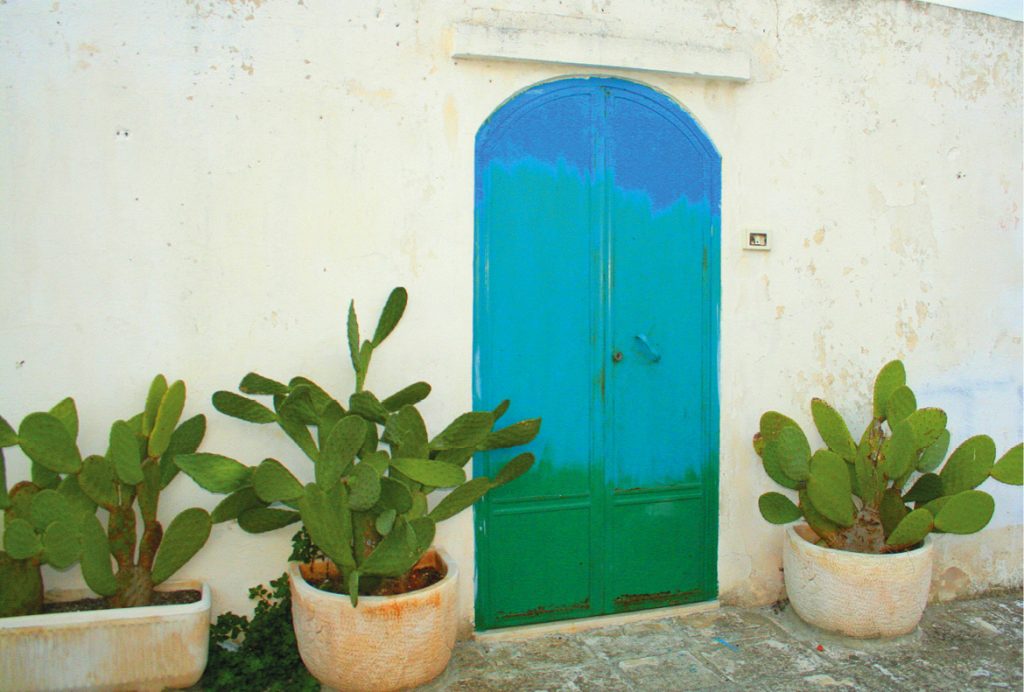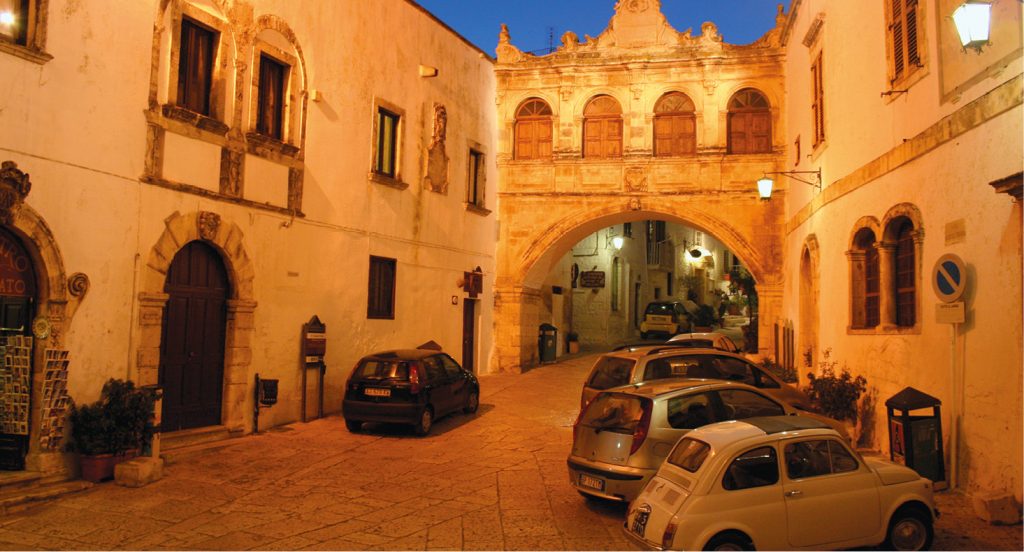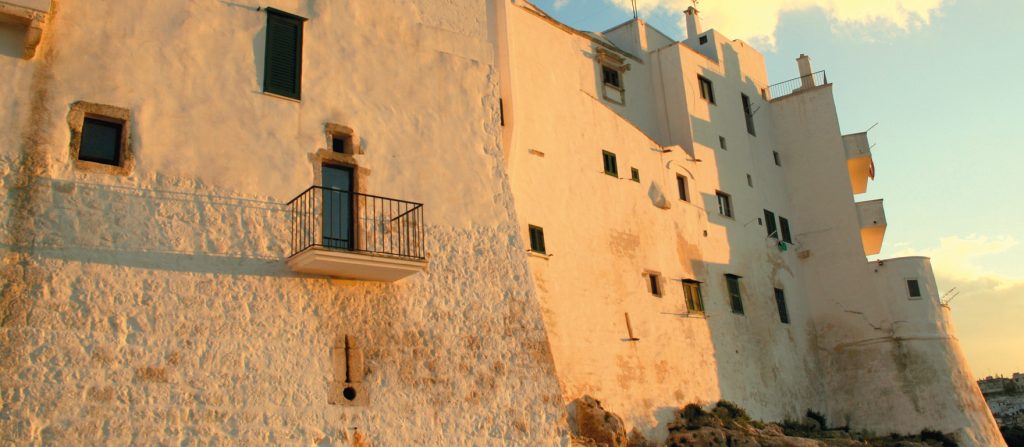The ancient hilltown of Ostuni, in Puglia, is a must-see for anyone visiting the high heel of Italy’s boot. Fleur Kinson leads you through the dazzling white maze of its streets
You’ll probably have your first sight of it while driving along Puglia’s coastal motorway – a glorified dual carriageway, quaintly lined down its central reservation with nodding oleanders.
Your eye will be drawn inland by the high, level-topped Murge plateau rising starkly from the pancake-flat littoral. And there on a little pinnacle, you’ll spy a tumbling pile of white and cream brightly lit by the sun. You won’t know what it is at first. Some sort of quarry? A huge marble monument? When you realize it’s a settlement, it quickly takes on a fairytale aura – a mythical white city seen from afar, possibly a mirage.
It grows ever larger and whiter on the landscape – and no less enchanted-looking – as you leave the tiny motorway and approach it along country roads flanked by hundreds of stout olive trees. When you reach the outskirts of town, even the first buildings you pass are pale and exotic-looking.
As you climb further into town, you glimpse through white townhouses a large, Indian-looking folly perched on the edge of olive groves. There’s a stern Baroque frontage embedded in the walls of a Cycladic-island-looking pile of buildings, and a majolica-tiled dome sprouting jauntily from the top of it all. ‘What crazy kind of place is this?’ you ask yourself.
History old and new
One of the most impressive small towns in all of southern Italy, Ostuni was ‘discovered’ by British visitors about thirteen years ago. The town has become an ever-firmer fixture on Puglia’s burgeoning tourist trail, and it’s easy to see why. Not only is Ostuni an impressive spectacle, it’s also perfectly sited to lure visitors its way.
Bríndisi airport is only a dozen miles off; Puglia’s highest concentration of wacky trulli sit in the nearby Itria Valley; and some lovely little beaches are only ten minutes out of town. Ostuni makes itself even more irresistible with a particularly lively calendar of public events, and an evening passeggiata. There’s always something going on here. The bars and cafés hum with life.
Ostuni divides into two main districts: the old and older parts of town. The merely old part sprang up in the 18th and 19th centuries. The older bit goes way, way back – at least two thousand years. Stone Age people were living in the Ostuni area about 50,000 years ago.
Lovers of pre-history should go and peer at ‘Delia’ on display in Ostuni’s Church of the Monacelle. She’s the 25,000-year-old skeleton of a pregnant woman found reverentially buried in a local grotto. But the definitive founders and christeners of Ostuni were the Italy-colonising ancient Greeks, who settled on the town’s highest hill in the 1st century BC, and to whom Ostuni was ‘astu-neon’ – simply, ‘new city’. Later generations of Italians re-built and re-modelled Ostuni’s hilltop clutch of buildings over many centuries, but the original Greek-village building style has always held sway.
All Greek to me
You’ll find the Greek flavour intense when you wander Ostuni’s white-washed, labyrinthine centro storico, but there’s an added element of the fantastical, too. The smooth-plastered homes sprout like an organic mass over their little hilltop, ranging up slopes and down curve-edged staircases, wiggling round ever-intriguing corners.
The moulded walls climb to private terraces and roof gardens, while the narrow alleys duck beneath random arches and sometimes stoop to form short tunnels. Every wall is white and blindingly bright in the sunshine; almost every door, shutter and window frame is Cycladic-island blue or turquoise.
The strangeness of the place is only amplified by its silence, and emptiness, at most times of day. Washing hangs profusely, so there are clearly people living here, but where are they? The only thing you hear occasionally is the cool breeze whisking round the alleys and under the archways. Being on a hilltop by the sea, Ostuni is almost always fresh and breezy, despite its dense network of closely-huddled buildings.
But the oddest thing in Ostuni’s higgledy-piggledy old town are the incongruous Baroque flourishes. Elaborately-carved ornamental doorways in weathered yellow stone are inexplicably embedded in the flat white plastered walls.
They stick out like sore thumbs on every lane and alleyway. It’s as if some historic loony once tried to ‘civilize’ the rustic Greek style by adding bits of grand ornament. Other Baroque effusions crop up unexpectedly elsewhere in Ostuni – the curlicued and bishop-topped obelisk overlooking Piazza della Libertà, for example, and a couple of imposing church frontages squeezed in among humbler buildings.
Around and about
If you wander Ostuni’s old town for long enough, you’re sure to emerge repeatedly onto the stunning vista it offers to the northeast. On the flat land far below, a wide, unbroken expanse of olive trees stretches to the sea. These aren’t the tame and delicate olive trees you’ve come to expect from, say, central Italy. Puglian olive trees are different. They’re monstrous with twisting trunks that look like they’ve each been caught in a tornado.
They live for centuries, and provide exceptionally high quality olive oil. To add to the unusualness of the scene, all the trees at the foot of Ostuni have been cropped into a cuboid shape. So the view is of thousands of leafy cubes, tumbling towards the blue Adriatic.
Having marvelled at the centro storico and its vista, you’ll probably want to roam Ostuni’s newer streets too. You’ll find them much straighter than the wriggling lanes of the old town, but surprisingly similar in feel and architecture. Having established a local style, Ostuni seems to have been reluctant to let it go. The whitewashed, vaguely Cycladic-cubic homes of the newer streets huddle close together. Cars put in an appearance, and there are a few more people on the pavement, but other than this there is little difference from the ancient part of town.
Whatever route you pursue, you always seem to end up back in Piazza della Libertà. This wide, triangular space is surely the heart of Ostuni, poised just between its oldest and newer parts. If evening is approaching after your day’s wanderings, you’re sure to sense the air of excitement radiating out from the piazza, as the whole town gears up for several hours of passeggiata.
You can take your pick from Ostuni’s excellent restaurants, then join the well-dressed throng on the pavements. Hours later, if you leave Ostuni the way you came, you’ll see that this ‘white city’ is now a glorious blaze of orange light set on high in the surrounding darkness. As the miles pass, it becomes a smaller and smaller shining beacon in the distance behind you. It looks as enchanted a place as it did in the daylight, if not even more so.




